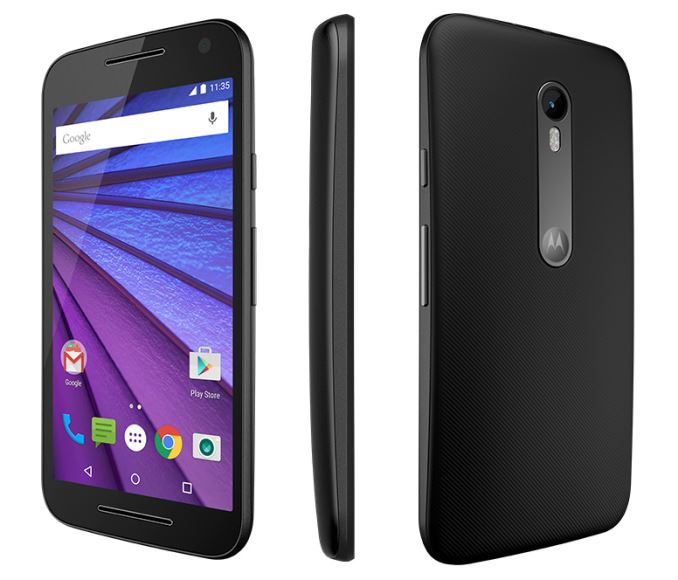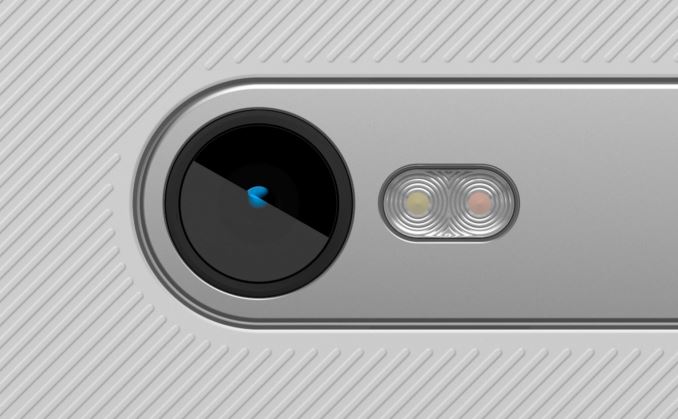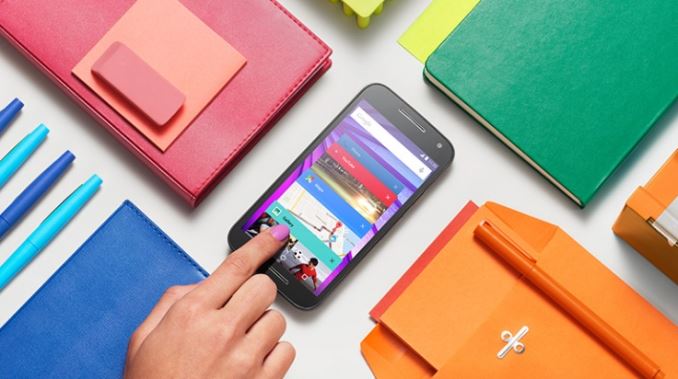Motorola Announces the New Moto G
by Joshua Ho on July 28, 2015 10:25 AM EST- Posted in
- Smartphones
- Qualcomm
- Motorola
- Mobile
- Moto G
- Snapdragon 410

Today, Motorola announced the successor to their Moto G, which has been their most successful phone in recent memory. It’s still called the Moto G, but this is the 2015 model which brings some long-needed updates to keep the Moto G fresh. These changes are far-reaching, and range from the SoC to the camera and design. In order to understand the new Moto G at a high level I’ve attached the specs below for those interested.
| Moto G (2014) | Moto G (2015) | |
| SoC | Snapdragon 400 1.2 GHZ A7 | Snapdragon 410 1.4 GHz A53 |
| RAM | 1GB | 1/2GB |
| NAND | 8GB NAND + microSD | 8/16GB NAND + microSD |
| Display | 5” 720p IPS |
5” 720p IPS |
| Network | 2G / 3G | 2G / 3G / 4G LTE (Category 4 LTE) |
| Dimensions | 141.5 x 70.7 x 11mm, 149g | 142.1 x 72.4 x 6.1-11.6mm, 155g |
| Camera | 8MP Rear Facing (Sony IMX179) f/2.4, 1.4 micron 1/3.06" sensor | 13MP Rear Facing (Sony IMX214) f/2.0, 1.1 micron 1/3.06" sensor |
| 2MP Front Facing | 5MP Front Facing | |
| Battery | 2070 mAh (7.87 Whr) | 2470 mAh (9.39 Whr) |
| OS | Android 4.4 (At Launch) | Android 5.1 (At Launch) |
| Connectivity | 2.4 GHz 802.11b/g/n + BT 4.0, USB2.0, GPS/GNSS |
2.4 GHz 802.11b/g/n + BT 4.0, USB2.0, GPS/GNSS |
| SIM | MicroSIM | MicroSIM |
| Launch Price | $179 (1GB/8GB) | $179 (1GB/8GB) $219 (2GB/16GB) |
Although specs are important, one of the most immediate changes to the Moto G this year is the new design. Instead of the all-plastic design that we were accustomed to with the previous two Moto Gs, the new Moto G has a new, grippier plastic back cover. The generally refreshed design helps a lot with distinguishing this model from previous years, and generally helps to increase the value proposition associated with the smartphone. Outside of design, there are a few key changes at a high level such as the camera, SoC, more RAM on the 16GB SKU, and water resistance. The battery is also bigger, at 2470 mAh compared to 2070 mAh of the last generation.
When it comes to the camera, it seems that this unit is directly shared with the Nexus 6’s camera, although it doesn’t seem to have the more expensive voice coil motor that is needed to enable OIS. There’s also a 5MP FFC, which should is a big step up from the 2MP FFC of the previous generation. The SoC moves from the Snapdragon 400 of previous generations to the Snapdragon 410, which means a move to the Cortex A53 on the CPU side. Given just how much higher the IPC is for the Cortex A53, general computing performance should improve here much like we saw with the Moto E moving to A53. The move from 1GB to 2GB of RAM is also a huge boon for multitasking performance, although this is only available on the more expensive 16GB variant. The 8GB variant will remain with 1 GB of RAM. The addition of IPx7 water resistance should also help greatly against water damage, as this means that the Moto G 2015 should be able to spend 30 minutes under a meter of still water without damage, although I still wouldn’t recommend trying to test that functionality.
The new Moto G is available online today from Motorola, Best Buy, and Amazon. The 8GB variant will start at 179.99 USD, and the 16GB variant will be available from Motorola’s website. The new Moto G will also support Motomaker, which allows for extensive color and material customization of a new smartphone.












52 Comments
View All Comments
tipoo - Wednesday, July 29, 2015 - link
You can use the Google launcher on the Mi4, it doesn't lock you into MiUI.quiksilvr - Tuesday, July 28, 2015 - link
The 2nd Generation Moto G did NOT have LTE, at least not in the United States. The 1st Generation Moto G had an LTE edition later in its launch cycle but as far as I know, the Moto G 2nd Generation (2014) did not have it in the US.quiksilvr - Tuesday, July 28, 2015 - link
Also something worth noting which is odd to say the least: The Moto G never had NFC? Why the hell not?Azusis - Tuesday, July 28, 2015 - link
I don't understand. Why would anyone want this over an ASUS ZenFone 2?For $199 ($20 cheaper than the best Moto G), you get:
- Larger 5.5" screen
- Higher resolution 1080p screen
- Larger battery
- More LTE bands / connectivity
hans_ober - Tuesday, July 28, 2015 - link
Larger screen is not better.Better battery life on the moto G, the Zenfone 2 is very inconsistent.
Pure Android
Waterproof
Azusis - Wednesday, July 29, 2015 - link
Great points. Going off of just the spec sheets the ZenFone 2 seems clearly better (for me), but after digging in a bit deeper to reviews / user reviews there seems to be a lot of QA/QC issues. Maybe some competition will help kick ASUS into gear.tipoo - Wednesday, July 29, 2015 - link
The larger battery doesn't mean more battery life, ATs own review showed it wasn't great there thanks to the inefficient panel, and maybe in some part the SoC. The camera was also a mixed bag, capable of great shots, but often didn't get them. Have yet to see what the third gen Gs camera will be like, but the battery life on my first gen one is almost amazing for a non-huge-battery phone.varad - Tuesday, July 28, 2015 - link
The Network column for the 2014 Moto G says LTE but i don't think it had LTE support [at least in the US]archish - Thursday, July 30, 2015 - link
Sad to see Motorola shipping 32 Android version on this phone even though hardware supports it!hans_ober - Sunday, August 2, 2015 - link
Is it true that the phone has no gyroscope? CPUZ output seems to show an Orientation sensor in addition to the accelerometers.Photospheres require gyroscopes!